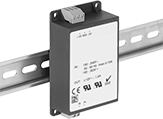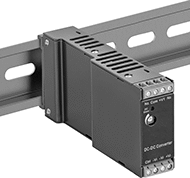Multiple-Voltage DIN-Rail Power Supplies

Power multiple devices with different voltages at the same time. These power supplies convert AC to DC voltage or step down high DC voltages to low DC voltages. Mount them to the DIN rails inside industrial cabinets and electrical panels, or unscrew the DIN clips to mount to any flat surface.
All of these power supplies use switching regulation, which means they produce the stated voltage despite fluctuations in your input power and the power being drawn by your system, and they won’t become too hot.
If you exceed the maximum temperature or load, these power supplies shut down to protect both the power supply and the connected equipment.
Rated IP20, they are designed to stop your fingers from touching internal components, which prevents accidental shocks. With various certifications, such as CE Marked, UL recognized, and C-UL recognized, these power supplies meet stringent safety standards. They have been safety tested for both AC and DC voltage inputs. They also meet specifications for UL 94 V-0, so they will self-extinguish within ten seconds if they catch fire, and won’t cause additional fires by dripping.
Maximum output noise is also known as ripple noise. The lower the value, the less interference the power supply creates. For most applications, a value over 100mVpp isn’t a problem. However, when using to power extremely sensitive electronics, such as audio equipment and high-precision measuring and testing equipment, you’ll want an output noise around 5mVpp or less.
Power factor shows how effectively a power supply draws AC power from the main electrical supply. The higher the power factor—up to a maximum score of 1—the lower your operating cost.
Efficiency describes how good a power supply is at converting the AC power it draws from your main electrical supply into DC power. High-efficiency power supplies cost less money to operate and produce less heat, meaning cooler temperatures in your electrical cabinet.
Output | |||||||||||
|---|---|---|---|---|---|---|---|---|---|---|---|
| No. of Output Power Connections | Voltage (Current) | Max. Output Noise Peak-to-Peak, mV DC | Power, W | Power Factor | Efficiency | Ht. | Wd. | Dp. | Specifications Met | Each | |
Single Phase—100-240V AC/100-353V DC Input Voltage | |||||||||||
Screw-Clamp Terminals Input and Output | |||||||||||
| 2 | 12V DC (1.2 A) -12V DC (1.2 A) | 240 240 | 30 | 0.56 @ 120 V AC 0.45 @ 240 V AC | 68% @ 120 V AC 68% @ 240 V AC 68% @ 110 V DC | 4.7" | 2.6" | 1.3" | UL Recognized Component C-UL Recognized Component UL 94 V-0 | 0000000 | 0000000 |
| 3 | 5V DC (3 A) 12V DC (0.6 A) -12V DC (0.6 A) | 100 240 240 | 30 | 0.55 @ 120 V AC 0.43 @ 240 V AC | 68% @ 120 V AC 68% @ 240 V AC 68% @ 110 V DC | 4.7" | 2.6" | 1.3" | UL Recognized Component C-UL Recognized Component UL 94 V-0 | 0000000 | 000000 |
DIN-Rail DC to DC Converters

Mount these DC converters to DIN rails on fixtures such as industrial cabinets and electrical panels. By converting voltages, they let you connect power supplies to equipment that requires a different input voltage. They’re often used to power sensors or other components that require a lower voltage than surrounding equipment. Since they send a stable, consistent voltage to equipment, they can also be used to correct power supplies that send uneven voltages. All meet U.S. and Canadian, or European Union, safety standards.
If you exceed current limits, these converters will shut down to protect your equipment. Some converters have overvoltage or overload protection, as well.
The lower a converter’s maximum output noise, also known as ripple noise, the less electronic interference it creates. These converters will work in most applications.
Output | |||||||||||
|---|---|---|---|---|---|---|---|---|---|---|---|
| Voltage | Current, A | Power, W | Max. Output Noise Peak-to-Peak, mV DC | Ht. | Wd. | Dp. | Mounting Fasteners Included | Specifications Met | Protections Provided | Each | |
Single Phase—9.5V DC-36V DC Input Voltage | |||||||||||
| -12V DC, 12V DC | 1.6 | 40 | 120 | 2.3" | 1" | 4.9" | No | CE Marked | Overcurrent, Overvoltage | 00000000 | 0000000 |
Single Phase—18V DC-75V DC Input Voltage | |||||||||||
| -12V DC, 12V DC | 1.6 | 40 | 120 | 2.3" | 1" | 4.9" | No | CE Marked | Overcurrent, Overvoltage | 00000000 | 000000 |
Output | ||||||||||
|---|---|---|---|---|---|---|---|---|---|---|
| Voltage (Current) | Power, W | Max. Output Noise Peak-to-Peak, mV DC | Ht. | Wd. | Dp. | Mounting Fasteners Included | Specifications Met | Protections Provided | Each | |
Single Phase—9.5V DC-18V DC Input Voltage | ||||||||||
| 5V DC (6A) 12V DC (0.4A) -12V DC (-0.4A) | 40 | 50 75 75 | 2.3" | 1" | 4.9" | No | CE Marked | Overcurrent, Overvoltage | 00000000 | 0000000 |
Single Phase—18V DC-36V DC Input Voltage | ||||||||||
| 5V DC (6A) 12V DC (0.3A) -12V DC (-0.3A) | 40 | 50 75 75 | 2.3" | 1" | 4.9" | No | CE Marked | Overcurrent, Overvoltage | 00000000 | 000000 |
Single Phase—36V DC-75V DC Input Voltage | ||||||||||
| 5V DC (6A) 12V DC (0.4A) -12V DC (-0.4A) | 40 | 50 75 75 | 2.3" | 1" | 4.9" | No | CE Marked | Overcurrent, Overvoltage | 00000000 | 000000 |
DC to DC Converters

When your power supply sends out DC power at a higher voltage than you need, change to the proper voltage with these converters. They’re often used when a specific component, such as a sensor, requires a lower voltage than surrounding equipment. Use them to correct power supplies that send uneven voltages, too—they provide electricity at a stable, consistent voltage. They mount on flat surfaces, and are commonly fastened inside enclosures.
If you exceed the current limit, these converters will shut down to protect your equipment. Some converters have overvoltage protection, so they’ll do the same if you exceed voltage limits.
The lower a converter’s maximum output noise, also known as ripple noise, the less electronic interference it creates. These converters will work in most applications.
Output | ||||||||||
|---|---|---|---|---|---|---|---|---|---|---|
| Voltage | Current, A | Power, W | Max. Output Noise Peak-to-Peak, mV DC | Ht. | Wd. | Dp. | Mounting Fasteners Included | Protections Provided | Each | |
Single Phase–9V DC-36V DC Input Voltage | ||||||||||
| -12V DC, 12V DC | 0.65 | 15.6 | 150 | 3.7" | 2.1" | 1.1" | No | Overcurrent | 00000000 | 000000 |
| -12V DC, 12V DC | 1.25 | 30 | 150 | 4.6" | 2.1" | 1.1" | No | Overcurrent, Overvoltage | 00000000 | 00000 |
Single Phase–18V DC-76V DC Input Voltage | ||||||||||
| -12V DC, 12V DC | 0.65 | 15.6 | 150 | 3.7" | 2.1" | 1.1" | No | Overcurrent | 0000000 | 00000 |
| -12V DC, 12V DC | 1.25 | 30 | 150 | 4.6" | 2.1" | 1.1" | No | Overcurrent, Overvoltage | 00000000 | 00000 |

























